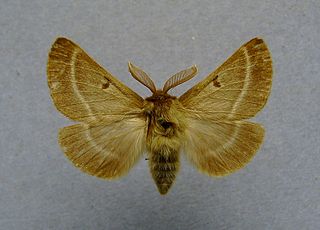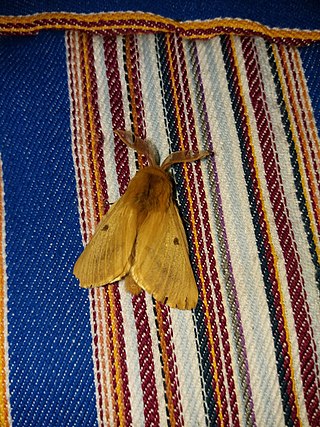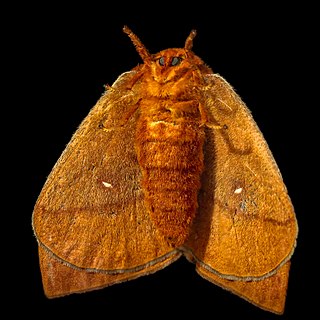
Bombycoidea is a superfamily of moths. It contains the silk moths, giant silk moths, sphinx moths, and relatives. The Lasiocampoidea are close relatives and were historically sometimes merged in this group. After many years of debate and shifting taxonomies, the most recent classifications treat the superfamily as containing 10 constituent families. Their larvae often exhibit horns.

Brahmaeidae is a family of insects in the order Lepidoptera, commonly known as Brahmin moths. It includes species formerly included in the family Lemoniidae.

The Bombycidae are a family of moths. The best-known species is Bombyx mori (Linnaeus), or silkworm, native to northern China and domesticated for millennia. Another well-known species is Bombyx mandarina, also native to Asia.

Apatelodidae, the American silkworm moths, is a family of insects in the order Lepidoptera. They are a family within the superfamily Bombycoidea, though they have in the past been considered a subfamily of Bombycidae.

Lemonia dumi is a species of moth of the family Brahmaeidae. It is found in scattered populations in Central Europe.

Lemonia taraxaci, the autumn silkworm moth, is a species of moth of the family Brahmaeidae. It was first described by Michael Denis and Ignaz Schiffermüller in 1775 and it is found in south-eastern Europe.

Lemonia balcanica is a species of moth of the family Brahmaeidae. It is found in the Balkans.

Lemonia vallantini is a species of moth of the family Brahmaeidae. It is found in Morocco, Algeria and Tunisia.

Lemonia is a genus of moths in the family Brahmaeidae (older classifications placed it in the separate family Lemoniidae.
Lemonia ballioni is a species of moth of the family Brahmaeidae. It was described by Hugo Theodor Christoph in 1888. The range includes Turkey, Ukraine and Russia.
Lemonia beirutica is a species of moth of the family Brahmaeidae. It was described by Franz Daniel in 1965. The range includes Israel and Lebanon.
Lemonia pauli is a species of moth of the family Brahmaeidae. It was described by Otto Staudinger in 1894. Its range includes Israel, Syria, Jordan and Lebanon.

Lemonia peilei is a moth in the family Brahmaeidae. It was described by Walter Rothschild in 1921.
Lemonia pia is a moth in the family Brahmaeidae. It was described by Rudolf Püngeler in 1902.
Lemonia ponticus is a moth in the family Brahmaeidae. It was described by Per Olof Christopher Aurivillius in 1894.
Lemonia sacrosancta is a moth in the family Brahmaeidae. It was described by Rudolf Püngeler in 1902.
Lemonia strigata is a moth in the family Brahmaeidae. It was described by Hans Rebel in 1910. It is also listed as a synonym of Lemonia taraxaci.
Saturnia mendocino, the Mendocino saturnia moth, is a species of silkmoth in the family Saturniidae. It was first described by Behrens in 1876 and it is found in North America.
Hemileuca stonei, the pangola-grass moth or Stone's buckmoth, is an insect in the family Saturniidae. The species was first described by Claude Lemaire in 1993. It is found in Central and North America.

Anisota consularis, the Florida oakworm moth or consular oakworm moth, is a moth in the family Saturniidae. The species was first described by Harrison Gray Dyar Jr. in 1896. It is found in North America.
This page is based on this
Wikipedia article Text is available under the
CC BY-SA 4.0 license; additional terms may apply.
Images, videos and audio are available under their respective licenses.











